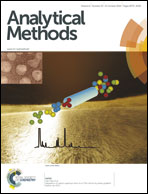Simultaneous determination of hydroquinone and catechol using an electrode modified by a composite of graphene/lanthanum hydroxide nanowires†
Abstract
A nano-complex of graphene and La(OH)3 nanowires (GR–La(OH)3) was prepared for the fabrication of a voltammetric sensor, which was used to simultaneously determine the two isomers of dihydroxybenzene, hydroquinone (HQ) and catechol (CC). The modified electrode exhibited excellent sensitivity and selectivity in the determination of HQ and CC mixed in a 0.1 M Na2HPO4–C4H2O7 buffer solution (pH 4.0). Both HQ and CC appear to be a pair of quasi-reversible redox peaks and the potential difference between oxidation peaks of HQ and CC was 112 mV. Under the optimized conditions, the oxidation peak current of both HQ and CC was linear in the range of 5 to 300 μM in the presence of 50 μM of the other one in the solution. The detection limit was found to be 0.015 μM for HQ and 0.01 μM for CC (S/N = 3). The proposed method was further successfully applied to the simultaneous determination of HQ and CC in artificial wastewater samples, and the results showed good stability and high reproducibility.


 Please wait while we load your content...
Please wait while we load your content...